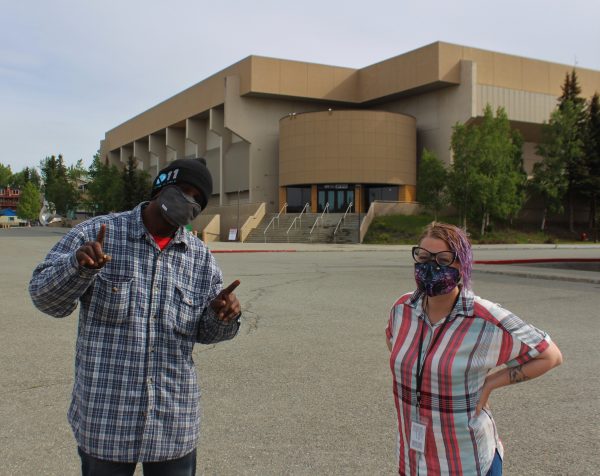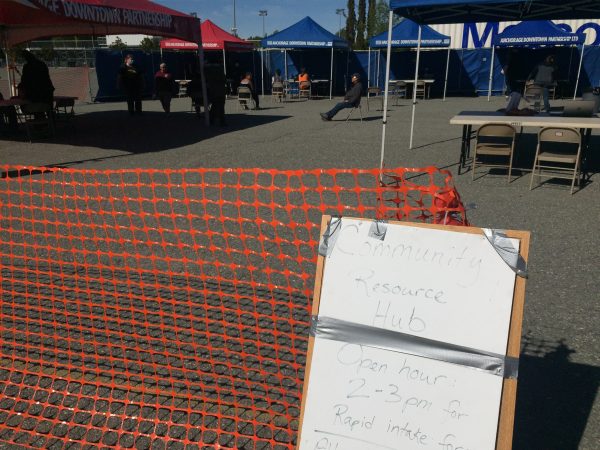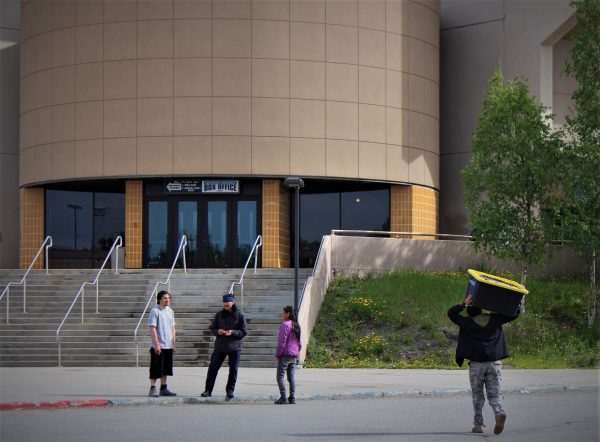
An economic downturn fueled by the global pandemic is an unlikely spot to find optimism, but advocates for the homeless in Anchorage say there are a few reasons to celebrate.
“I think the community should be really proud,” said Lisa Sauder, the executive director of Bean’s Cafe, which is running the emergency mass shelters at Ben Boeke and Sullivan Arenas since the pandemic forced the organization to find a new home with more space.
In part, that’s because there have been no positive COVID tests among Alaska residents experiencing homelessness. But there are also other reasons, and advocates credit the pandemic with shaking up the way the city deals with homelessness.
Get the latest coverage of the coronavirus in Alaska
“In crisis, there’s a really awesome opportunity to make some fundamental changes. And you know, everything was lit in fire and that includes the red tape,” said Katelyn Sheehan, who has been helping people find services at emergency mass shelters at Boeke and Sullivan.
A big part of what she is referring to revolves around about a dozen tents in the parking lot outside of the arenas. There, workers are helping direct people in need to service providers who can help them with housing, a job, or getting an ID.

It seems like a small step, but previously, a person experiencing homelessness would have to bounce around the city to different providers carrying their possessions on their back or in a shopping cart.
“As our clients come into shelter, they are assessed by the navigation team, and we do a rapid intake form that plugs directly into our homeless management information system. And in that intake form, we identify their needs and their characteristics that qualify them for the patient,” said Sheehan.
There are other things that are different about the Sullivan and Boeke shelters. Residents can leave their belongings in the shelter, provided they come back every night before curfew.
“In the past, we kind of had the model of we had day shelter and we had night shelter and people had to transition back and forth, and haul everything they owned with them,” said Sauder, “And, you know, that’s just not I think the best way to treat people and it makes it a lot more difficult for people to find employment opportunities.”
RELATED: Alaska rolls out plan to use hotels, dorms to quarantine health care workers and homeless families
Residents say that there’s more security and less theft. The 6-foot physical spacing between the cots has also made for a healthier atmosphere.
“At the previous location, you had people, like they were a sardine can every square foot of the floor was taken up by a mat. This has been able to provide people with the necessary space,” said Christopher Constant, an Anchorage assemblyman. He says regardless of any data, it’s simply more humane.
People at the shelter say it’s a step up from Brother Francis Shelter, the permanent emergency shelter downtown. Danny Braden has been staying at the which shelter. On Monday morning, he was taking a break from carrying supplies from Boeke to Sullivan.

“[It’s] much better. People here are actually willing to step up a little bit and clean and those volunteers were at the brother Francis shelter they weren’t,” he said.
Being able to start over at a new place has let everyone start on a clean slate to some extent, says Braden.
“There’s just a lot more help here. You don’t have to protect your belongings with everything you have. You’re able to go out and look for work and know that you’re still gonna be able to get back,” he said.
A companion, Christopher Wolf, agrees.
“It’s been really, really helpful. There’s nice people inside, willing to help you give clothes, give you food if you’re hungry. I’m waiting on housing myself,” he said.
Limited data out seems to back up the idea that the new shelters have been a success. According to numbers released from the Anchorage Coalition to End Homelessness, 97 people went from being homeless to being housed in April during the middle of the pandemic. That’s up from 73 in March.
But use of the Sullivan is limited. The current contract with the arena lasts through July, and though many hope to extend that longer, it won’t be there forever. And the solution isn’t perfect.
RELATED: City to stop using Ben Boeke as emergency mass shelter
Assemblyman Constant said that in some ways, moving the shelter to the Sullivan just moved the problem of partying and drug use to a different area. While previously it was concentrated near the shelter downtown, now it’s concentrated in the areas surrounding the Sullivan. Recently, the city did a massive clean up in the woods along the Campbell Creek trail.
“And so if you look at down at 3rd Avenue, it’s become a lot less chaotic. There aren’t people camping on the streets. Rarely do you see people using the street as a public toilet right now. But some of that has moved here into the surrounding neighborhoods, which is a challenge for any of these operations, how are you going to mitigate the impacts off-site of your campus?” he said.
Now it’s moved to other areas. On Monday, he said he saw evidence of drunkenness and partying on the streets that was concentrated on 13th and Gambell.
“You can go by now and see there’s like, a three-inch thick pile of trash there for the last couple of weeks,” he said.
Leaders say that getting people into a shelter where they can have access to services and develop trust with providers, is one of the only ways to keep the situation from a crisis. A national study predicted that the number of homeless could rise by 45% due to the pandemic. Luckily, federal funding has given the city some breathing room.
Housing and Urban Development funding paid for the move to Sullivan, which means that money previously allocated for running the shelter can be reassigned. To that end, the city recently put out a request-for-proposals with $180,000 in funding to start an intense outreach campaign to get individuals who are experiencing homelessness off the street and into shelters.
For the longer term, Constant and others in the Assembly are advocating for a way to ease the concentration of homelessness from one area – be it downtown or Midtown – by building multiple shelters, each with their own resource hub.
“I’ve come to call that is the mini continuum of care, where in several locations across town, you set up an emergency shelter, some form of transitional housing, some form of permanent supportive housing and they shelter place where people can go. So they don’t have to be out on the streets. So they have a place to eat. And so they have a place to go to the bathroom,” said Constant.
Assemblywoman Meg Zaletel says that the city is considering revising some zoning requirements that would allow some of those shelters to be built where they’re needed.
“That puts shelters in makes more areas available for shelter. And that helps us put shelter in the right kind of spots which are on transit corridors and near services,” she said.
She said that seeing the model in action at the Sullivan gives evidence that it can work.
“When they access through shelter, we’re able to stay during the day for engagement and have that peace, man and work with them through the shelter system to ladder out of homelessness,” she said.
Send your questions about the pandemic in Alaska to coronavirus@alaskapublic.org or leave us a message at 907-586-1600
Lex Treinen is covering the state Legislature for Alaska Public Media. Reach him at ltreinen@gmail.com.





